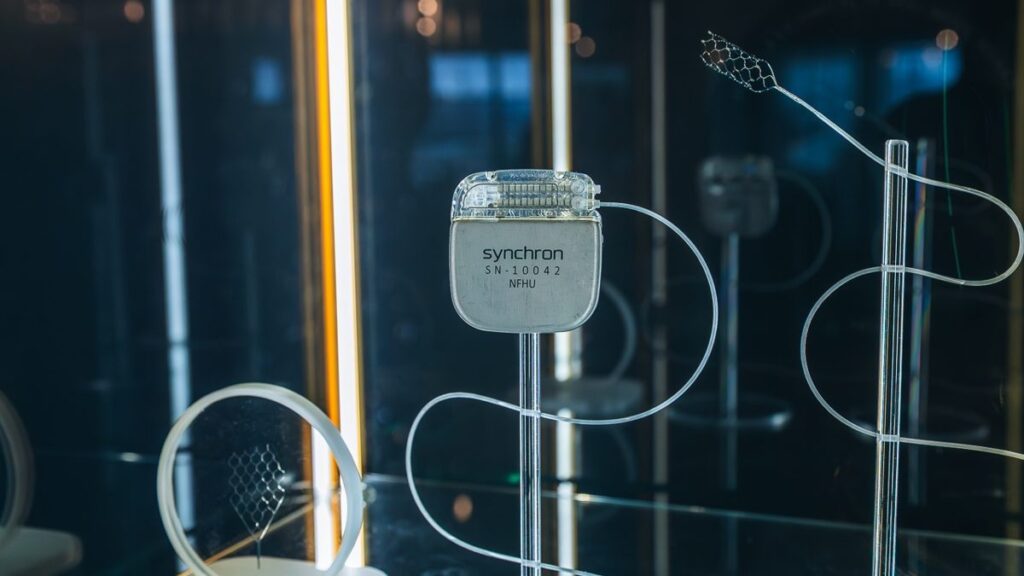
You can now officially control an Apple device with your thoughts, provided you have the Stentrode brain implant developed by New York City-based company Synchron. This groundbreaking capability, first announced in May, connects brain-computer interfaces (BCI) to Apple products via a Bluetooth connection. This means that iPads, Macs, and other Apple devices recognize a BCI in the same way they would a keyboard or mouse.
Apple has designed this integration to serve as a standard connection for all implants, including those from Elon Musk’s Neuralink. However, Synchron is the first to offer this capability to its patients. In a video released on Synchron’s YouTube channel, patient Mark Jackson, who suffers from ALS, demonstrates using his Stentrode implant to control his iPad “entirely by thought,” according to Synchron. Jackson can “navigate the iPad home screen, open apps, and compose text all without using his hands, voice, or eyes.”
Breaking New Ground in Assistive Technology
While this new feature may still have some kinks to work out, the ability to seamlessly connect with a widely used consumer device significantly enhances the patient experience. “When I lost the use of my hands, I thought I had lost my independence,” says Jackson. “Now, with my iPad, I can message my loved ones, read the news, and stay connected with the world, just by thinking. It’s given me part of my life back.”
To be fair, patients with the Synchron Stentrode or Neuralink N1 could already connect to Apple devices, but these connections were nonstandard, built by Synchron or Neuralink. The significance of the new hookup lies in its status as an official method for BCI companies to integrate with Apple devices, unlocking a new set of Apple-supported features.
Signal Strength: A Game Changer
A key component of the upgraded Apple experience is the signal strength meter, which appears on the screen when Jackson thinks about selecting an icon or app. A blue box appears over the app to indicate the strength of the connection, measuring whether he will be able to select it successfully. The stronger the signal, the more blue shading appears within the box.
“Signal strength is a game changer because it gives patients real-time insight into how well their thoughts are being detected by the system,” says Kurt Haggstrom, COO of Synchron. “If a patient sees low signal strength before selecting something, they might take a moment to refocus their attention or re-engage their motor intent.”
CEO Dr. Tom Oxley compares the feature to “how you can see your hand move toward the coffee cup before you grab it,” providing patients with more insight into how effectively they and their implant are working together, without needing to consult trained clinicians for performance troubleshooting.
Implications for the Future of Human-Computer Interaction
“Mark’s experience is a technical breakthrough, and a glimpse into the future of human-computer interaction, where cognitive input becomes a mainstream mode of control,” says Oxley. A rare tour of Synchron’s office and technology in July revealed that the Apple connection is the result of years of collaboration with Cupertino to refine and test the product on Synchron patients.
Although the Federal Drug Administration (FDA) has not yet approved BCIs for sale, and only patients with severe paralysis have tried them, Synchron hopes to one day make them widely available as consumer tech. The Apple integration “marks a critical step in making BCI technology practical, scalable, and integrated into the global consumer ecosystem, moving beyond clinical trials into everyday life,” Synchron states.
Looking Ahead: The Path to Mainstream Adoption
The announcement comes as the tech industry increasingly explores the potential of brain-computer interfaces. With companies like Neuralink and Synchron leading the charge, the integration of BCIs into consumer technology could revolutionize how individuals with disabilities interact with the world, offering new levels of independence and connectivity.
As the technology continues to develop, experts anticipate a future where BCIs become a common tool for human-computer interaction, not just for those with disabilities but potentially for the broader public. The move represents a significant stride toward a future where our thoughts directly control our digital environments, reshaping the landscape of personal technology.
Meanwhile, Synchron’s ongoing collaboration with Apple and other tech giants underscores the importance of partnerships in driving innovation and accessibility in the tech industry. As these technologies continue to evolve, the implications for healthcare, communication, and personal autonomy are profound, heralding a new era of interaction between humans and machines.







